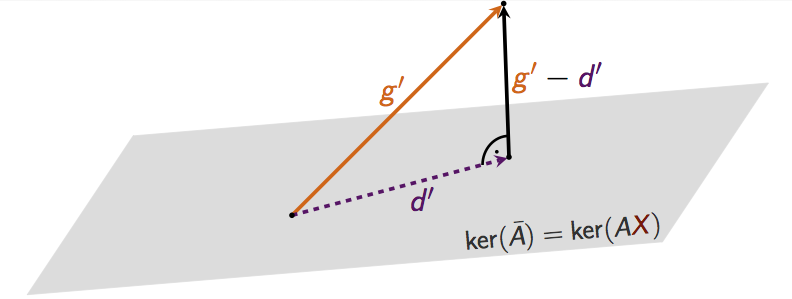
informatik



| Lecture time: | Wed, 10-12 and Fri, 14-16 | ||||
|---|---|---|---|---|---|
| Lecture room: | HS001, E1.3 | ||||
| Lecturers: | Andreas Karrenbauer | ||||
| Teaching Assistant | Max John | ||||
| Tutors | Cornelius Brand, Davis Issac, Omar Darwish, Stephan Friedrichs | ||||
| Good textbooks on the topic include: |
|
||||
| Tutorials: |
|
||||
| Prerequisites: | Basics in linear algebra, discrete mathematics, calculus, algorithms, and complexity. At Saarland University these topics are covered in the bachelor courses Mathematik für Informatiker 1 & 2, Grundzüge der Theoretischen Informatik, and Grundzüge von Algorithmen und Datenstrukturen. | ||||
| Exam Information: | Your final grade will be the best of the final exam and the re-exam.
You may bring one A4 cheat sheet (double-sided, in your own handwriting)
to the exams.
|

This course provides an introduction to fundamental concepts and algorithmic methods for solving linear and integer linear programs.
Linear optimization is a key subject in theoretical computer science. Moreover, it has many applications in practice. A lot of problems can be formulated as (integer) linear optimization problem. For example, combinatorial problems, such as shortest paths, maximum flows, maximum matchings in graphs, among others have a natural formulation as a linear (integer) optimization problem. In this course you will learn:
To this end, basic concepts from polyhedral theory will be introduced. The simplex algorithm and the ellipsoid method will be presented. The lecture concludes with exact and approximation algorithms for NP-hard optimization problems. There will be theoretical and practical exercises.

This is a 9-credit-point core lecture ("Stammvorlesung"). There will be two lectures and one exercise session per week. We will hand out exercises every week (usually worth 40 points) and each student should score at least 50% in the first half of the course (first 6 exercise sheets) and 50% in the second half in order to be allowed to take the exam.
You can also gain points by writing lecture notes of single lectures. In order to do so, you have to use our template. You gain 40γ points for the notes of one lecture, hereby γ denotes the quality factor in between 0 and 1 that will be determined by us. Please submit your notes by sending a zipped package that contains everything such that your tex code compiles and the pdf to Max not later than one week after the lecture that you took notes for. You can use the old notes from last year. If you need any tex source while writing your own notes, you can ask Max to send you the required parts.
The slides of all lectures will be condensed in a handout.
| Date | Topic | Reference | Homework | Notes |
|---|---|---|---|---|
| Apr 22 | Overview | Exercise Sheet 1; Solution 1 | Slides | |
| Apr 24 | Integer Programming | Chapter 6 in [W] ; Chapter 11.8 in [BT] | Slides; Scribe | |
| Apr 29 | Branch and Bound | Chapter 7 in [W] ; Chapter 11.2 in [BT] | Exercise Sheet 2; Solution 2 | Slides; Scribe1; Scribe2 |
| May 1 | No lecture: Public holiday | |||
| May 6 | Duality | Chapter 4.7 in [BT] | Exercise Sheet 3; Solution 3 | Slides |
| May 8 | Duality | Slides; Scribe1; Scribe2 | ||
| May 13 | Fourier-Motzkin-Elimination, Farkas' Lemma | Chapters 2.8 and 4.6 in [BT] | Exercise Sheet 4; Solution 4 | Slides; Scribe |
| May 15 | Strong duality, Facets, Vertices | Chapters 4.3 and 2.2 in [BT] | Slides; Scribe1; Scribe2 | |
| May 20 | Extreme points, vertices and basic feasible solutions | Chapter 2.2 in [BT] | Exercise Sheet 5; Solution 5 | Slides; Scribe1; Scribe2 |
| May 22 | Optimality of extreme points, standard form | Chapters 2.6 and 2.3 in [BT] | Slides; Scribe1; Scribe2 | |
| May 27 | Degeneracy, basic (feasible) directions, reduced costs | Chapters 2.4 and 3.1 in [BT] | Exercise Sheet 6; Solution 6 | Slides; Scribe |
| May 29 | Optimal bases, development of the Simplex method | Chapters 3.1 and 3.2 in [BT] | Slides | |
| Jun 03 | Simplex - The full tableau implementation | Chapter 3.3 in [BT] | Exercise Sheet 7; Solution 7 | Slides; Scribe |
| Jun 05 | Introduction to the Ellipsoid method - volume of polyhedra | Chapter 8 in [BT] | Slides; Scribe | |
| Jun 10 | The Ellipsoid method | Chapter 8 in [BT] | Exercise Sheet 8; Solution 8 | Slides; Scribe |
| Jun 12 | The Ellipsoid method | Chapter 8 in [BT] | Slides | |
| Jun 17 | Introduction to the interior point method | Chapter 9 in [BT] | Exercise Sheet 9; Solution 9 | Slides; Scribe |
| Jun 19 | The interior point method | Chapter 9 in [BT] | Slides; Scribe1; Scribe2 | |
| Jun 24 | Integer optimization | Chapter 3.2 in [W] | Exercise Sheet 10; Solution 10 | Slides; Scribe1; Scribe2 |
| Jun 26 | Generalization to polyhedra, unimodular matrices | Chapter 3.2 in [W] | Slides; Scribe1; Scribe2 | |
| Jul 01 | Total unimodular matrices, network flows | Chapters 7.3,7.4 in [BT] ; Chapters 3.2, 3.3 in [W] | Exercise Sheet 11; Solution 11 | Slides; Scribe1; Scribe2 |
| Jul 03 | Network flows | Chapters 7.3,7.4 in [BT] ; Chapter 3.3 in [W] | Slides; Scribe | |
| Jul 08 | Network flows | Chapters 7.3,7.4 in [BT] ; Chapter 3.3 in [W] | Exercise Sheet 12; Solution 12 | Slides; Scribe |
| Jul 10 | Recap, Interior point method for network flows | Slides | ||
| Jul 15 | Max-Flow Min-Cut, Bipartite Matching, Hall's theorem | Chapter 8.2 in [MG] | Exercise Sheet 13; Solution 13 | Slides; Scribe |
| Jul 17 | Matching polytopes, Approximation algorithms | Chapter 25 in [S] | Slides; Scribe | |
| Jul 22 | Approximation algorithms | Test exam | Slides | |
| Jul 24 | Max-Cut and SDP relaxations | Slides | ||
| Jul 29 | Final exam | E2.5, HS 1 | ||
| Jul 31 | Possibly exam review | |||
| Sep 29 | Re-exam (start time: 1:30pm) | Günther-Hotz-Hörsaal |